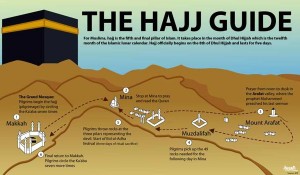The fifth Pillar of Islam is the pilgrimage to Makkah and its surroundings known as Hajj.
All Muslims are obligated to make Hajj once in their lifetimes if they can afford it and are otherwise able to do so.
The Hajj is made from the eighth to the twelfth of the Islamic month of Dhul-Hijjah.
Muslims travel from all over the world to perform Hajj. The rituals are themselves simple, but the amount of walking necessary, the hot climate, and the crowds make the Hajj a rigorous exercise in faith. Still, between 2 and 3 million people perform Hajj every year, and millions more yearn to do so.
To perform Hajj, pilgrims enter a state of consecration known as ihram. In this state they may not clip their nails, cut or pluck any hair, or have any sort of sexual contact.
Male pilgrims wear special clothes consisting of two seamless strips of cloth, one covering the back and shoulders, the other covering from the waist to the knees. Female pilgrims can wear ordinary clothing that covers everything but the face and hands.
The rituals of Hajj date back to the time of Prophet Ibrahim (Abraham) and commemorate his willingness to sacrifice his only son, Isma`il (Ishmael). During the days of Hajj, the pilgrims attempt to forget all about their most basic worldly needs and to focus their attention and devotion on Allah Alone.
Upon arriving to Makkah, the pilgrims first circumambulate the Ka`bah seven times in a ritual known as Tawaf. This ritual reminds the pilgrims that Allah (God) should be the focus and center of their lives.
The next ritual is Sa`i, which is walking back and forth seven times between the hillocks named as-Safa and al-Marwah. This commemorates the search for water made by Hajar (Hagar) when Prophet Ibrahim (peace be upon him) left her and her infant son Isma`il (peace be upon him) in the desert.
On Dhul-Hijjah 8, pilgrims head to Mina, where they spend the day supplicating Allah. Early the next morning they go to `Arafah (or `Arafat). They spend the day supplicating Allah and begging for His forgiveness. Many stand on the Mount of Mercy to supplicate, though this is not necessary. When the sun sets on the Day of `Arafah, the pilgrims’ sins are forgiven.
After sunset the pilgrims move on to Muzdalifah, where they spend the night and collect pebbles to be used in the next ritual.
The next morning, Dhul-Hijjah 10, is the Day of Sacrifice. Most pilgrims slaughter a sheep or goat, and the meat is distributed to the poor. (Muslims who are not on Hajj also slaughter that day, which is known as `Eid Al-Adha.) The ritual commemorates Ibrahim’s willingness to sacrifice his son Isma`il (peace be upon them both) and Allah’s provision of a ram as a substitute sacrifice.
But before slaughtering, the pilgrims go to throw pebbles at the stone pillars known as Al-Jamarat. This ritual commemorates Ibrahim’s stoning of Satan when the latter tried to tempt him to disobey Allah.
After this, the pilgrims cut or shave their hair (women cut off only a small amount) and return to Makkah to repeat Tawaf and Sa`i. They sleep at Mina and repeat the stoning of the pillars on the next two days. A final Tawaf before leaving Makkah completes the Hajj.
Many pilgrims also go to Madinah before or after Hajj in order to pray in the Prophet’s Mosque and visit his grave, although this visit to Madinah is not obligatory.
The above is only a summary.
There is some variation in the performance of Hajj, depending on whether the individual pilgrim chooses to also perform `Umrah (often known as the lesser pilgrimage) beforehand and whether this will be while in one prolonged state of ihram or two separate ones for `Umrah and Hajj.
Source: OnIslam










It’s crucial that you notice that results like these are just potential with
Garcinia nutritional supplements which contain a minimum of
60% HCA.
Garcinia WOn’t make you jittery, make your heart race, or help you to stay awake
at night as there is no caffeine in the product.
The second thing Garcinia cambogia does is inhibit the fat-generating enzyme Citrate Lyase, making it difficult for the body to turn carbs
into fat.
Cracker, as you pointed out, exercising its the only sustainable way to reduce and keep a good and healthy
weight.
Chromium is a mineral that’s frequently lacking in our diets as we get older and a chromium shortage can promote weight gain and
perhaps diabetes.
But even with their ties to business, which are common in the age of university-corporate partnerships, the group of critics stand to gain nothing from criticizing Dr.
Oz – it is a smokescreen.
Beaucoup de gens ont plusieurs questions concernant l’efficience et l’efficacité
du Garcinia Cambogia pillule de perte de poids.